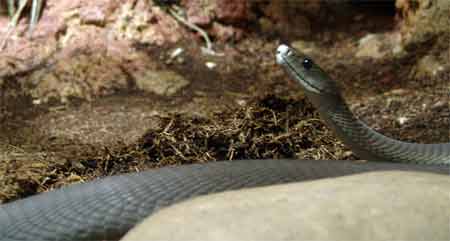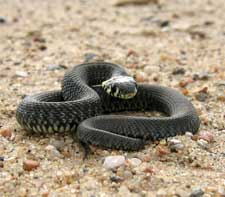|
 Killer Snake: The Black Mamba is a territorial snake and will normally retreat
from danger. However, this snake will become very aggressive if
it feels threatened, especially if the threat is standing between
the snake and its lair. When in its aggressive mode, the mamba will
rear its head as high as possible, even sometimes being able to
look directly into the eyes of an averaged sized human depending
on the snake's size. It will arch its back and advance rapidly while
balanced on the rear third of its body, jaws open to reveal the
inky black inside of its mouth while hissing very aggressively.
Its bite delivers about 100 mg of venom; 10 to 15 mg is deadly to
a human adult. When hunting small animals it delivers a single bite
and backs off, waiting for the nerve toxin in its venom to paralyze
the prey. If the prey is a bird, it will usually hang on to the
bird waiting for the venom to take effect. If fighting off a threat,
it will deliver multiple deadly strikes. Death is due to suffocation
resulting from paralysis of the muscles used for breathing. Even
though its venom is not the most toxic gram for gram, due to its
aggressive nature and large quantity of venom delivered as well
as its speed, it is widely regarded as the most dangerous snake
in the world.
Killer Snake: The Black Mamba is a territorial snake and will normally retreat
from danger. However, this snake will become very aggressive if
it feels threatened, especially if the threat is standing between
the snake and its lair. When in its aggressive mode, the mamba will
rear its head as high as possible, even sometimes being able to
look directly into the eyes of an averaged sized human depending
on the snake's size. It will arch its back and advance rapidly while
balanced on the rear third of its body, jaws open to reveal the
inky black inside of its mouth while hissing very aggressively.
Its bite delivers about 100 mg of venom; 10 to 15 mg is deadly to
a human adult. When hunting small animals it delivers a single bite
and backs off, waiting for the nerve toxin in its venom to paralyze
the prey. If the prey is a bird, it will usually hang on to the
bird waiting for the venom to take effect. If fighting off a threat,
it will deliver multiple deadly strikes. Death is due to suffocation
resulting from paralysis of the muscles used for breathing. Even
though its venom is not the most toxic gram for gram, due to its
aggressive nature and large quantity of venom delivered as well
as its speed, it is widely regarded as the most dangerous snake
in the world.

Snake's Lair: Black Mambas spend their nights in holes in the ground - usually
disused burrows - or hiding deep among fallen rocks or timber. These
hiding places are also fled to by the snake if it becomes alarmed
and it will attack any creature blocking the path to its hole.
Cold Blooded: Like all reptiles, the Black Mamba is cold blooded, and relies
on external heat to maintain its body temperature. Therefore, it
frequently basks in the sun during the day, either on a low branch
or a rock, but during the summer, the snake may be forced to take
cover in its burrow if it becomes too hot.
Eagle Eyes: Black Mambas travel quickly across rough ground or along low tree
branches when hunting. They are able to hold their heads up to 1m
above the ground when striking, and can hold them 50cm above the
ground even when moving. They have very good eyesight and can strike
their prey - rodents, bats, birds and lizards like lightning, leaving
their powerful venom to finish off the kill.
The venom is injected through two hollow fangs at the front of
its mouth which lie flat until the snake bites something, at which
point small, movable mouth bones erect them. The venom causes rapid
paralysis. Enzymes in the snake's saliva start to digest the prey
before it even reaches the stomach, and most prey is digested within
a few hours.
 The Black Mamba is the second longest venomous snake in the world,
and is also the fastest moving snake in the world; it can go up
to twenty-three miles per hour. The Black Mamba is the second longest venomous snake in the world,
and is also the fastest moving snake in the world; it can go up
to twenty-three miles per hour.
Snake Stories: Stories abound about Black Mambas chasing people for miles and
visiting houses to kill every single person inside. All are exaggerations.
Black Mambas are not as fierce as people describe them. They only
use their speed as a defense mechanism to get away from any possible
threat. In captivity Black Mambas are docile and appreciative animals
that show a fantastic and active behavior when housed in a big enclosure
the right way.

Summer Romance: Breeding takes place in spring and early summer. Males may travel
long distances looking for females. After mating, the snakes return
to their own holes. Females lay between 10 and 25 eggs, usually
in decaying vegetation. The decomposition of the vegetation gives
off heat, which helps to warm the eggs and speed up hatching time.
The shells of the eggs allow water and oxygen to reach the developing
embryos.
Mamba Babies: Black Mamba hatchlings are around 51cm long, and grayish-green
in color. They are independent immediately and can catch prey the
size of a small rat. Within a year, they reach 2m. Young mambas
are eaten by mongooses, and even adult mambas are eaten by the secretary
bird and larger species of eagle.
The Black Mamba can grow to a maximum size of around 14 feet, but
the average size is about 3. It has an average lifespan of up to
twelve years in captivity. Foods in the diet of the Black Mamba
include: Lizards, birds, rodents and other small mammals.
All text is available under the terms
of the GNU Free Documentation License
|